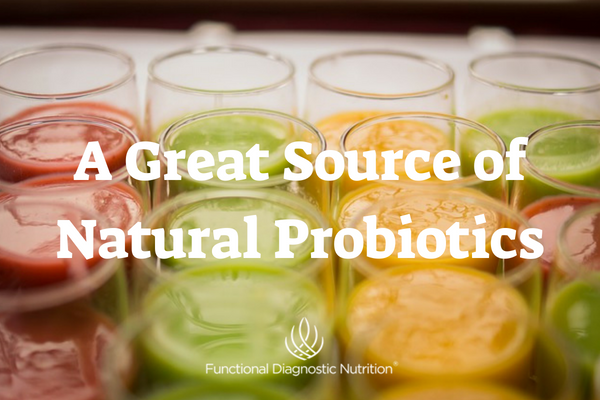Probiotics have become a popular health topic, and although a lot of people are taking probiotic supplements, many of them don’t know what probiotics actually are, why they’re beneficial, and what the best sources of them are.
The term probiotic, meaning “for life” in Greek, was originally intended to identify the microorganisms that support good intestinal health. Probiotic supplements have become so common that they have now become the more dominant definition, but this doesn’t mean that they’re the best or only source.
The Importance of Probiotics
Healthy intestinal function is the foundation of optimal health and is dependent on the delicate balance of intestinal bacteria. Because probiotics help to maintain this balance, they can make a significant contribution to our overall health.
The most common type of probiotic is the Lactobacillus bacteria, particularly L. acidophilus. These bacteria exist in many places including the human digestive tract and foods such as dairy, fruit, and vegetables. In the intestines, the lactic acid produced by these bacteria promote a favorably acidic pH that inhibits the growth of some undesirable bacteria and facilitates the absorption of protein and a number of minerals including calcium, copper, iron, magnesium, and manganese.
Some strains of Lactobacillus acidophilus also have natural antibiotic and cancer fighting properties. These strains are particularly beneficial against infectious bacteria such asStreptococcus (strep), Staphylococcus (staph), Salmonella, Clostridium botulinum, and E. coli. Some strains of L. acidophilus have even shown impressive effects against viral infections including polio, HIV, and herpes, and can also produce hydrogen peroxide which has the potential to kill undesirable Candida yeast and prevent it’s overgrowth.
The Best Source of Health Promoting Probiotics
Because probiotics have become very popular, there are plenty of questionable probiotic products with deceptive marketing and labeling. Dannon’s DanActive, a processed dairy drink containing probiotics, is an excellent example. As part of a recent lawsuit settlement, Dannon has agreed to remove their immune boosting claims from the DanActive label. Yogurts and other similar products are also commonly advertised as having beneficial cultures of probiotics, but in many cases, they’re highly processed and the sugar that they often contain will negate most of the probiotic benefits.
Although supplements are by far the most popular source of probiotics, I don’t think this is the best source. My preference is to take as few supplements as possible, which is often none at all, and to get as much nutrition as possible from whole foods. As such, my preferred source of probiotics is fermented foods. Although probiotic supplements can be very effective, they’re clearly not as natural as fermented foods, they don’t provide all of the same benefits, they can be costly, and as with any supplement, it can be difficult to verify their quality.
The Basics of Fermentation
Fermentation is a simple and natural process used by many ancient cultures to preserve food, promote good digestion, and improve health. The Lactobacillus bacteria responsible for fermentation inhibit the action of the putrefying bacteria that cause food to spoil. These bacteria proliferate during fermentation and can also improve a food’s enzyme content, increase it’s levels of vitamins B, C, and K, deactivate undesirable nutrients such as the protein inhibitors and phytic acid found in soy, and help to release nutrients from food that would otherwise pass through the intestines undigested an not be absorbed.
Vegetables, fruit, and dairy are some of the most commonly fermented foods, and even people who are lactose intolerant can usually enjoy fermented dairy products because theLactobacillus bacteria that they contain digests the lactose. However, people who have food sensitivities to dairy are still likely to experience symptoms from fermented dairy products.
Fermented foods are typically used as a condiment and are not meant to be consumed as a significant portion of a meal. Using fermented and homemade condiments such as ketchup and mustard is a great way to incorporate the health benefits of fermented foods into your diet while also eliminating unhealthy store bought condiments that are highly processed.
How to Make Your Own Fermented Food
The following steps describe how to ferment vegetables and fruit which are arguably the easiest and healthiest foods to ferment on your own.
- Wash the food and cut it into pieces.
- Put the cut pieces into a bowl, add sea salt, and pound the pieces to release their juice. You can also add herbs or spices for added flavor.
- Put the food pieces and their juice into a wide mouth jar leaving about an inch of space at the top. Make sure to seal the jar tightly to prevent air from getting in as this will interfere with fermentation.
- Keep the jar at room temperature for 2 to 4 days.
- Store the jar in a dark and cool place at about 40 degrees Fahrenheit. Either a cold basement or the top shelf of a refrigerator will suffice.
When making fermented food, it’s important to use organic produce and unrefined sea salt. In addition to being better for your health, the purity and high nutritional value of these items are necessary to support the fermentation process.
Although you can eat the fermented food immediately following the initial 2 to 4 days, vegetables tend to increase in flavor with time. When making sauerkraut, some people even recommend letting it mature for at least 6 months. In contrast, fermented fruits should be eaten within two months of their preparation. For recipes and additional information about fermented foods, including fermented dairy products, I highly recommend Nourishing Traditions by Sally Fallon.
Tips for Buying Fermented Food
Just as if you were making your own fermented food, any product that you buy should ideally contain organic ingredients, unrefined sea salt, and be produced through natural lactic acid fermentation. Because natural fermentation can be unpredictable and inconsistent, most food manufacturers don’t want to be bothered with its inconvenience. As a result, most commercially fermented products are vinegar based and don’t provide the same benefits as natural lactic acid fermentation. A brand that I often buy is Real Pickles. They have a variety of different products and use high quality ingredients. Some of the more commonly available fermented vegetable products include sauerkraut (cabbage), pickles (cucumbers), beets, and carrots.
Although the fermentation of milk will replenish some of the enzymes and other nutrients destroyed during pasteurization, it’s best to buy fermented dairy products that are made with raw milk from pasture raised livestock. As I previously mentioned, it’s also important to avoid fermented foods that are processed such as flavored yogurt and gimmicky probiotic drinks like Dannon’s DanActive. Some of the more commonly available fermented dairy products include yogurt, hard cheese, cottage cheese, and kefir.
[1. Fallon, Sally with Enig, Mary. Nourishing Traditions.]
[2. Rubin, Jordan and Brasco, Joseph. Restoring Your Digestive Health.]
[3. Daniel, Kayla. The Whole Soy Story.]
[4. Rubin, Jordan. The Maker’s Diet.]
[5. Schrezenmeir, Jürgen and de Vrese, Michael Probiotics, prebiotics, and synbiotics – approaching a definition. American Journal of Clinical Nutrition. February 2001. 73(2).]







